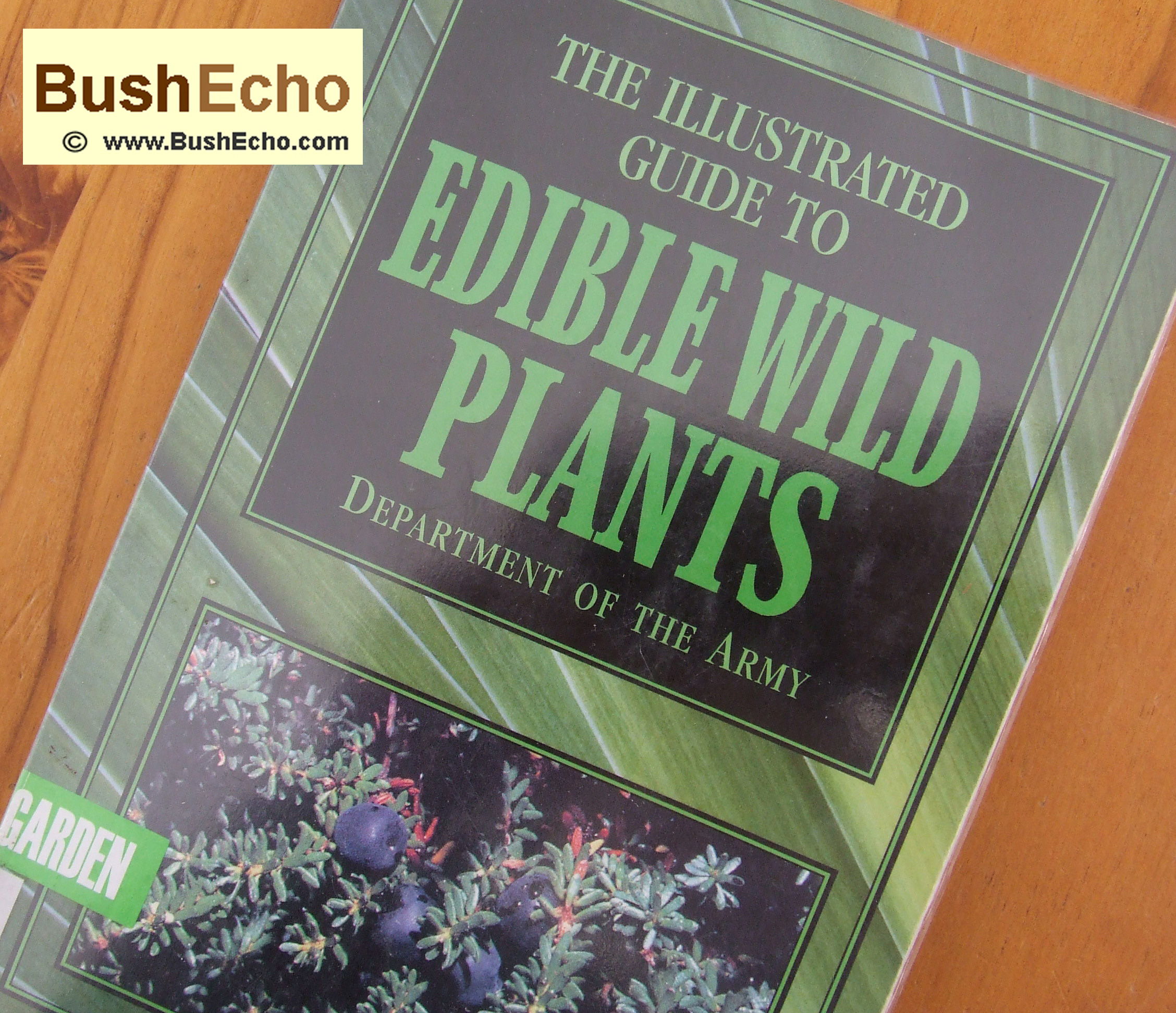Grey saltbush (Atriplex cinerea) is found along some coastal areas of Australian and salt marshes. It is a great plant to know for bushcraft and survival, as it is versatile wild edible for cooking and pretty tasty.
In some places it is an abundant shrub and easy to forage for. It is also easy to identify with the blueish / grey leaves and can have a silvery sheen. (The Grey saltbush looks a bit like the big sagebrush, Artemisia tridentate.)
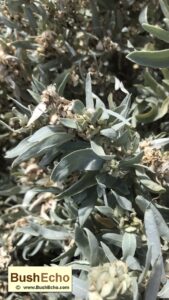
Above – Grey saltbush. (Atriplex cinerea)
When foraging, make sure the area is away from roadside pollution, drains and chemical runoffs. Inspect the plant and pick only the healthy looking leaves, free from bugs and discoloration. Shake the plant to remove any unseen insects.
Warning – Never eat a plant that is not positively identified. Ensure you do not accidentally collect other poisonous plants when foraging which are mixed in.
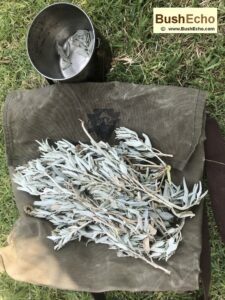
Above picture – The Campcraft Outdoors XL haversack, to help collect the edibles.
The recipes.
Here are two basic recipes. One for the bush or camping with limited cooking condiments and equipment.
The other recipe is for the home with more cooking options.
Grey saltbush – simple bush tucker recipe.
1. Place the grey saltbush leaves in a fry pan. (Or billy pot, French army or British mess kit tin.)
2. Add some vegetable oil into the pan. As some bushcrafters, campers, or hikers sometimes carry a bit of vegetable oil, I thought I would include it in the recipe. (Also the oil doubles up for maintaining knives and axes, etc.)
3. Pan Fry until cooked.
If you had no billy tin or fry pan, you could bake the saltbush on a flat rock in the fire.
Home basic recipe.
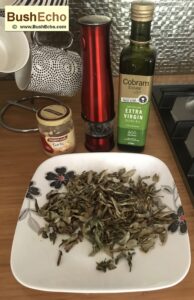
1. Place the grey saltbush leaves in a fry pan or wok.
2. Add some olive oil into the pan. Add a teaspoon of crushed garlic and a touch of pepper.
3. Pan Fry until cooked.
(Optional – Use peanut oil instead of olive oil. Add some paprika, ginger or chili flakes for some spice.)

Foraging wild edible tips.
Grey saltbush has been traditionally added in to flavor meat, however, it can be nice in stir fries, or it can be deep fried as well. When dried it can also be used as a herb to flavor doughs. Also it can be used a substitute for salt.
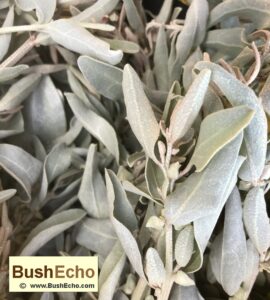
Add some saltbush to roasts. Or use as stuffing for fish or placed around the fish when cooking. It goes well with seafood and as a leafy vegetable it can be steamed.

Above image – A feast of pan fried grey saltbush to the left and boiled saltwater mussels in the pot. Note, one piece of prickly pear cactus left on the blue plate, which was the entrée. I forgot to take photos of the sea urchins which were eaten raw and also pan fried up with garlic and pepper.
Hot and cold.
It is suggested to cook it first. The saltbush once cooked, is also nice cold, like a bar snack, that is moreish and hard to stop at one taste. Some batches reminded me of the plain flavor, but salty Doritos corn chip.
Some friends and family members commented it tasted similar to popcorn. I am not sure about that, but it is pretty nice for an abundant wild edible.

When picking the leaves, a little bit of leaf stalk (The petiole that attaches the leaf to the stem.) tastes okay when cooked. So you don’t have to be too fussy picking every single leave individually off.
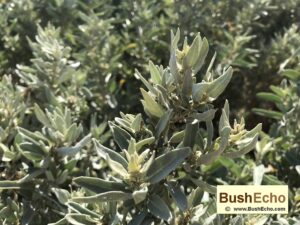
The seeds can be roasted. (I haven’t tried them yet.)
I am unsure about the roots of the grey saltbush and if they are edible or not. The shrub is used to stabilize sand dunes, so I imagine the root system would be wide spread. As it is easy to pick the leaves and they help the sand dunes, there is probably no sense in harvesting the whole plant.

I noticed that the salty taste can vary a fair bit from locations. On one day I foraged the plant from a certain location and cooked it up. The next day I harvested from a different location and it seemed saltier, but still nice. In the second location the bushes were closer to the sea and even possible exposed to the high tide sea levels. I am not sure if it was the location, age, size of the plant, cooking time, or perhaps just my taste buds.
Some research suggest the grey saltbush can be used as a substitute for spinach. When boiled, I thought it was like most leafy type greens, but with a salty taste. (Sautéed in butter would be worth a try.)

Above image – Fried grey saltbush in the lid to the left, boiled grey saltbush in the Zebra billy tin. Freshly foraged leaves in the yellow dry bag.
There is apparently over eighty species of saltbush. Grey saltbush (Atriplex cinerea) can also be called barilla or coast saltbush.
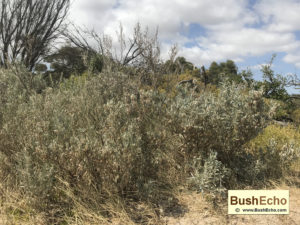
Crushed leaves are said to be used to relieve insect bites and scratches.
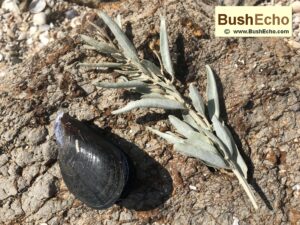
Above picture – The saltbush can easily be broken off with the hand and doesn’t require any special tools or knives. For tougher shrubs though, a shellfish, like this muscle shell can be used as a makeshift cutting tool to help with foraging.
Summary.
The grey saltbush is an adaptable wild edible that can be boiled, stir fried, baked and more.
As a stand-alone dish, or it can be added to many recipes for a side dish or mix in with some main meals for some flavor. A good bush tucker plant to learn for bushcraft and survival, or just to forage and cook it, for a tasty snack.
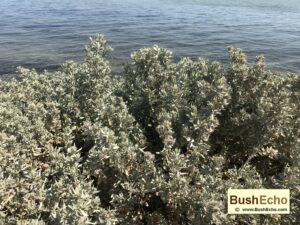
References and Resources – Field Guide to Useful Native Plants From Temperate Australia, by J.M. Caton, R.J. Hardwick. Wild Food Plants of Australia, by Tim Low. Noongar Bush Tucker, Bush Food Plants and Fungi of the South-West of Western Australia, by Vivienne Hansen & John Horsfall. Wild Food in Australia, by A.B. & J.W. Cribb.
Affiliate Links – This article may contain some affiliate product and Amazon affiliate links. This comes at no additional cost to the reader, and helps to support the website. Thank you.
Copyright © by BushEcho. Content on this site cannot be copied and is protected by copyright law. Please contact the author/s for permission.
Disclaimer – This information is for educational purposes only. The author/s and website disclaim liability for any damage, mishap, or injury that may occur from engaging in any activities or ideas from this site.

